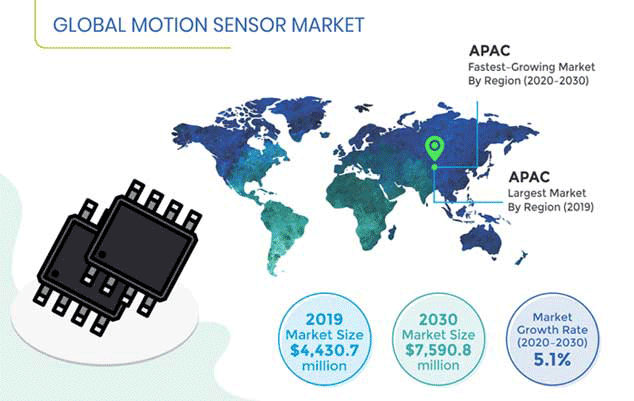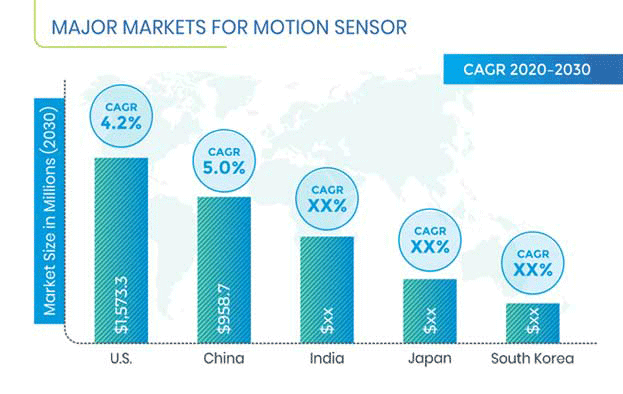Report Code: 11830 | Available Format: PDF | Pages: 162
Motion Sensor Market Report: By Technology (Active, Passive), Type (Infrared, Ultrasonic, Tomographic Sensor, Accelerometer, Gyroscope, Combo sensor), Application (Consumer Electronics, Automobile, Medical Device, Building Automation, Industrial Equipment) - Competition Analysis and Growth Forecast to 2030
- Report Code: 11830
- Available Format: PDF
- Pages: 162
- Report Description
- Table of Contents
- Market Segmentation
- Request Free Sample
Market Overview
In 2019, the motion sensor market value stood at $4,430.7 million, and it will witness a CAGR of 5.1% during 2020–2030, to reach $7,590.8 million by 2030.
Across the globe, the market will demonstrate the fastest growth in the Asia-Pacific (APAC) region in the coming years. This is primarily credited to the soaring requirement for motion sensors in India, Japan, Indonesia, South Korea, and China because of the surging manufacturing of tablets, smartphones, lighting systems, gaming consoles, electronic medical devices, and building automation equipment, itself due to the rapid urbanization and increasing purchasing power of residents.

MEMS-Based Motion Sensors Becoming Primary Trend among Consumer Electronics Firms
One of the major trends currently being witnessed in the industry is the production of microelectromechanical system (MEMS)-based motion sensors. MEMS, manufactured on a silicon wafer, offer economies of scale, as thousands of sensors can be manufactured in a single batch process. The most-widely used types of MEMS-based motion sensors are magnetometers, gyroscopes, and accelerometers, which find wide application in smart wearable devices, medical equipment, and smartphones. While people’s rising disposable income is fueling the demand for smartphones, the growing geriatric population and chronic disease burden are driving the requirement for medical equipment, including wearable trackers.
Motion Sensor Market Report Coverage
| Report Attribute | Details |
|---|---|
|
Historical Years |
2014-2019 |
|
Forecast Years |
2020-2030 |
|
Market Size in 2019 |
$4,430.7 Million |
|
Revenue Forecast in 2030 |
$7,590.8 Million |
|
Growth Rate |
5.1% CAGR |
|
Report Scope |
Market Trends, Drivers, and Restraints; Revenue Estimation and Forecast; Segmentation Analysis; Country Breakdown; Companies’ Strategic Developments; Market Share Analysis of Key Players; Company Profiling |
|
Countries Covered |
U.S., Canada, Germany, France, U.K. Italy, Spain, Netherlands, Russia, China, Japan, India, Australia, South Korea, Vietnam, Thailand, Philippines, Indonesia, Brazil, Mexico, Argentina, Colombia, Saudi Arabia, U.A.E, Turkey, South Africa, Algeria |
Booming Consumer Electronics Sales Strongest Growth Driver for Market
One of the major factors fueling the expansion of the motion sensor market is the burgeoning requirement for consumer electronics. Motion sensors are extensively used in heart rate monitors in smart wearable devices and for controlling the orientation of smartphone screens. The mushrooming requirement for wearable devices and smartphones among young people, especially the millennials, is propelling the sales of motion sensors. Furthermore, with the surge in the global population, the sales of consumer electronics are predicted to rise, thereby propelling the requirement for motion sensors in the forthcoming years.
Rising Adoption of Internet of Things Major Opportunity for Market Players
The increasing usage of internet of things (IoT) devices is a major opportunity for the players in the market for motion sensors. The IEEE estimated the total number of IoT devices in use around the world in 2017 at 27 billion. The institute further expects this number to rise to 125 billion by 2030. With the incorporation of IoT capabilities, motion sensors can monitor the physical status of a device from a remote location. Furthermore, these devices have the ability to improve various building automation applications, such as heating, ventilation, and air conditioning (HVAC) controls and lighting systems, thereby helping save energy and drive down emissions.
Passive Motion Sensors Witnessing Higher Sales due to Rising MEMS Demand
In 2019, the passive category contributed the higher revenue to the motion sensor market, under the technology segment. This category is also predicted to demonstrate the faster growth in the forthcoming years owing to the surging requirement for MEMS and passive infrared (PIR) motion sensors. Passive MEMS motion sensors are mainly used in medical devices, industrial machinery, and consumer electronics, the demand for all of which continues to burgeon with the rising population and its increasing purchasing power.
Combo-Type Sensors Are Most Popular due to Their Higher Accuracy
In 2019, the type segment of the market was dominated by the combo sensor category, in terms of revenue. This is ascribed to the microfabrication of several types of motion sensors into a single device, which provides higher accuracy in detecting motion. Combo sensors are used in consumer electronic devices, such as smartphones, where the gyroscope, magnetometer, and accelerometer are integrated into a single MEMS system.
Motion Sensor Integration Picking Pace in Building Automation Applications
The building automation category is predicted to demonstrate the highest growth rate under the application segment of the market in the upcoming years. This is attributed to the growing requirement for green buildings on account of the increasing concerns over global warming. In this regard, the building automation technology is required for using power efficiently and reducing the carbon footprint, thereby propelling the expansion of this motion sensor market category. Furthermore, motion sensors are deployed as occupancy sensors, wherein they carry out dedicated functions, such as the on/off function of HVAC systems and lighting. This saves manual effort and drives down the consumption of electricity, which has become necessary to reduce the emission of greenhouse gases.
APAC Is Largest and Fastest-Growing Motion Sensor Market
Geographically, Asia-Pacific (APAC) is the largest procurer of these instruments, and it will also experience the fastest growth in the motion sensor market during the forecast period. This is credited to the fact that this region is the biggest consumer electronics market in the world, led by India, Thailand, Indonesia, South Korea, Japan, and China.
In APAC, the industry is predicted to demonstrate the fastest growth in India because of the progress of the country’s electronics industry. As per the India Electronics and Semiconductor Association (IESA) and Invest India, the country’s electronics industry will attain a value of $400 billion by 2025. Furthermore, the increasing number of commercial projects, particularly offices and residential buildings, and upcoming sports events are predicted to push up the demand for building automation. Motion sensor market players will seek to leverage this opportunity to increase their sales revenue and enhance their position in the industry.

Competitive Landscape of Motion Sensor Market
The motion sensor is highly fragmented and a mature market. Several major players in the market include Analog Devices Inc., Panasonic Corporation, Honeywell International Inc., Robert Bosch GmbH, STMicroelectronics N.V., and NXP Semiconductors N.V., Schneider Electric SE, Eaton Corporation plc, Murata Manufacturing Co. Ltd, Koninklijke Philips N.V., and TE Connectivity Ltd.
Changing market dynamics due to factors such as growing demand for autonomous and electric vehicles, security and surveillance systems, building automation, medical devices, and others, is projected to drive the market in the coming years. This is projected to intensify the competition among the market players during the forecast period.
Motion Sensor Market Size Breakdown by Segment
The motion sensor market report offers comprehensive market segmentation analysis along with market estimation for the period 2014–2030.
Based on Technology
- Active
- Passive
Based on Type
- Infrared
- Ultrasonic
- Tomographic Sensor
- Accelerometer
- Gyroscope
- Combo sensor
Based on Application
- Consumer Electronics
- Automobile
- Medical Device
- Building Automation
- Industrial Equipment
Geographical Analysis
- North America
- U.S.
- Canada
- Europe
- U.K.
- France
- Germany
- Italy
- Spain
- Netherlands
- Russia
- Asia-Pacific
- China
- Japan
- India
- Australia
- South Korea
- Vietnam
- Thailand
- Philippines
- Indonesia
- Latin America
- Mexico
- Brazil
- Argentina
- Colombia
- Middle East & Africa
- Saudi Arabia
- U.A.E.
- Turkey
- South Africa
- Algeria
Key Questions Answered in the Report
- What is the current scenario of the motion sensor market?
- What are the key strategies companies are adopting to increase their consumer base?
- What is the historical and the present size of the market segments and their future potential?
- What are the key categories within the market segments and their future potential?
- What are the major catalysts for the market and their expected impact during the short, medium, and long terms?
- What are the opportunities for the players in the market?
- Which are the key regions from the investment perspective?
Want a report tailored exactly to your business strategy?
Request CustomizationWant an insight-rich discussion with the report author?
Speak to AnalystOur dedication to providing the most-accurate market information has earned us verification by Dun & Bradstreet (D&B). We strive for quality checking of the highest level to enable data-driven decision making for you
Our insights into the minutest levels of the markets, including the latest trends and competitive landscape, give you all the answers you need to take your business to new heights
With 24/7 research support, we ensure that the wheels of your business never stop turning. Don’t let time stand in your way. Get all your queries answered with a simple phone call or email, as and when required
We take a cautious approach to protecting your personal and confidential information. Trust is the strongest bond that connects us and our clients, and trust we build by complying with all international and domestic data protection and privacy laws